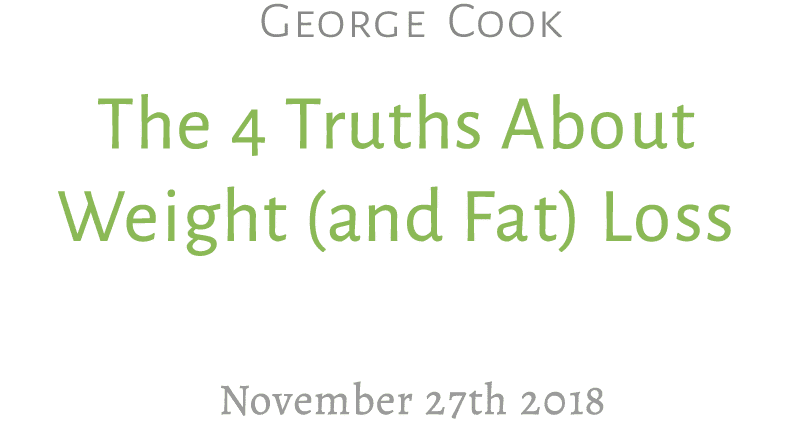



One of the most misguided topics of fitness is that of weight-loss. With thousands of different celebrities, personal trainers and even doctors all sharing their own unique ideas to what worked for them, we’ve created one of the biggest misconceptions in human health and wellbeing.
I’ve worked with clients who believe you burn fat by working a specific muscle, by breathing in certain ways, by wearing certain clothes, by not eating late at night and every other possible scenario you can think of.
Even though each person is individually unique with their own body, all reacting in different ways with different requirements. Eventually, it all boils down to a common few points with the most vital factors first.
Nutritional Balances
The most important factor that contributes to any physical health change within the body is our essential nutrient balance which includes your vitamin, mineral, antioxidant and phytochemical levels. The base reason for human’s needing to consume food is to get our essential nutrients so that the body functions at its best.
These nutrients are vital for the processes of the body. Without them, the body is forced into a major state of deficiency where every single one of the thousands of bodily processes is seriously affected.
This includes the ability your body has to hold on to muscle, to get rid of excess fat, to properly metabolise food, to feed the muscles with the right nutrients on top of hundreds of thousands of other processes within the body. Without them, you’re always fighting a losing battle.
“The most important factor that contributes to any physical health change within the body is our essential nutrient balance which includes your vitamin, mineral, antioxidant and phytochemical levels. The base reason for human’s needing to consume food is to get our essential nutrients so that the body functions at its best.”
Total Caloric Consumption and Expenditure
The next biggest factor in regards to weight-loss is that of our total caloric consumption and our total caloric expenditure. Our entire body is constantly using a form of metabolic energy that is obtained through food.
If there is more energy consumed via food that is expended, the excess energy is stored as fat. If there is less energy consumed via food than there is expended, the body consumes energy from its fat stores to accommodate the deficiency. Note that it takes consistency over time for either of these changes to come about.
Caloric surplus – weight gain
Caloric deficiency – weight loss
The reason this comes second in the list, however, is due to the fact that without proper nutrients, these numbers will be completely out of whack. Where someone malnourished may have to eat a surplus of 1000 calories to gain a small amount of muscle, someone with balanced nutrition may only have to eat around 250 calories extra. Simply because our body ‘wastes’ that which it can’t use.
Although there are many online calculators you can use to get a rough estimate, the only way you can really find our your unique needs is to consume roughly the same set amount of calories over a period of time (two weeks for example) and observe the results on the scales yourself.
For a rough marker, every 3,500 calories equates to around 1lb of weight gain. Meaning if you consume a 500 calorie deficit every day, after a week you will lose around 1lb and vice versa. Of course, this will vary from person to person but it works as a rough guide.
Level of Physical Activity
Linking back into our total caloric consumption and expenditure, the level of physical activity you do will have a great impact over changes in body weight. To put it simply, the more physically active you are, the more calories you’re going to be burning as you do so.
Someone who is very sedentary in their job or their lifestyle as a whole, who drives everywhere and sits down the vast majority of their day is going to be requiring dramatically fewer calories each day to maintain their weight than someone who walks or cycles everywhere, you have an active or physically labouring job and doesn’t like to watch the television for example.
Some people don’t need to do anything more specific to lose weight, the lifestyle they lead already does that for them and so they maintain that throughout their day to day with ease. Others, who lead much lesser active lives are going to have to do a lot more in their ‘free-time’ to counter the lack of physical exertion in other parts of their lives.
If there is more energy consumed via food that is expended, the excess energy is stored as fat. If there is less energy consumed via food than there is expended, the body consumes energy from its fat stores to accommodate the deficiency. Note that it takes consistency over time for either of these changes to come about.
Caloric surplus – weight gain
Caloric deficiency – weight loss
The reason this comes second in the list, however, is due to the fact that without proper nutrients, these numbers will be completely out of whack. Where someone malnourished may have to eat a surplus of 1000 calories to gain a small amount of muscle, someone with balanced nutrition may only have to eat around 250 calories extra. Simply because our body ‘wastes’ that which it can’t use.
Although there are many online calculators you can use to get a rough estimate, the only way you can really find our your unique needs is to consume roughly the same set amount of calories over a period of time (two weeks for example) and observe the results on the scales yourself.
For a rough marker, every 3,500 calories equates to around 1lb of weight gain. Meaning if you consume a 500 calorie deficit every day, after a week you will lose around 1lb and vice versa. Of course, this will vary from person to person but it works as a rough guide.
Style of Training
Finally, the last key factor when it comes down to weight loss and body composition change as a whole is that of the style of training. Although it still plays a vital role in any changes that are made to the body, without the first 3 factors, there’s next to no benefit to the specific type of training you do.
If you have managed to get your nutrition us a little better, understand your body’s own unique caloric needs and located the times where you’re able to be active consistently and put your body through work then your style of training is going to be the part that shapes it all (literally!).
Just as a bodybuilder training for a competition wouldn’t spend 6 hours a day riding a bicycle to get himself built, there’s little benefit to someone attempting a bodybuilder style workout if they’re trying to burn the pounds – it may be useful, but it’s hardly ideal. Once again, every person’s body reacts differently to different things and what may work for one person, won’t work for another but to lay out some simple groundwork:
Fat-loss – High-Intensity Interval Training (HIIT)
Weight-loss – Steady State Cardio
Muscle gain – Heavy Resistance Training
Muscular Endurance – Light Resistance Training
As someone who wants to lose fat specifically and more than likely wants to hold on to their figure and attempt to ‘tone’ the body, the best route is a blend of HIIT alongside light to medium resistance training.
Enter your email below to receive weekly advice, empowerment and exclusive offers!
*If you can’t find your confirmation, check your spam/junk folder as sometimes emails can get misplaced
Sources:
Mandl, F. (1988) [1971]. Statistical Physics (2nd ed.). Chichester,New York,Brisbane,Toronto,Singapore: John Wiley & sons. ISBN 978-0471915331.
https://nutritionstudies.org/healthy-weight-loss-80-nutrition-20-exercise/
https://www.foodforfitness.co.uk/hiit-cardio-weight-loss/

